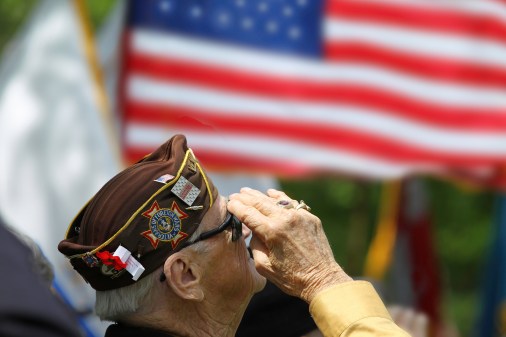The Department of Veterans Affairs has completed a series of one-on-one meetings with companies interested in taking on what is perhaps the biggest, most complex and important government IT challenge since the rollout of healthcare.gov — replacing VA’s antiquated patient scheduling system with commercial technologies that will enable veterans to see doctors and receive treatment when and where they need it.
The department is scheduled this month to release a request for proposals for its Medical Appointment Scheduling System, which will replace the patient scheduling module within the Veterans Integrated System Technology Architecture, VA’s main electronic health record system known as VistA. The scheduling system has been at the heart of the scandal involving veterans who died waiting for care after being placed on so-called secret wait lists. But VA officials recently outlined an aggressive plan to completely overhaul VistA scheduling along with the cultural and business process challenges that have contributed to VA’s problems.
“We need to solve scheduling because this is our core mission,” said Mike Davies, director of the Access Clinic Administration Program at the Veterans Health Administration, speaking June 18 at a MASS industry day hosted by VA. “We want to make appointments just in time [and] we want truth in scheduling.”
A VA spokesperson told FedScoop the agency is still finalizing the acquisition process and the timeline for the contract.
VistA’s scheduling module plays a much more fundamental role in the larger cycle of patient care and VA operations than previously disclosed. VistA scheduling not only gets veterans appointments, but the data generated by the scheduling system is critical to the long-term management of VA’s medical practices and finances. Everything from health trends in specific populations of veterans to the amount of federal reimbursements provided to individual VA clinics is tied to the VistA scheduling system. Adding to the importance of a robust scheduling module are VA’s plans for telehealth, an army of home care providers that is offline in remote locations for extended periods of time and the agency’s plans for mobile and Web-based self-service applications.
“There are three things we have to measure: We have to know patient demand — how many appointments are made or created in a given timeframe; we have to know supply — how many appointment slots are available to meet that demand; and we have to know activity — how many of those appointments are actually completed,” Davies said. In addition, VA needs to know the cancel rate (which currently stands at a whopping 13 percent and is attributed largely to problems with VistA), the reschedule rate, the cancel and reschedule rate (those who cancel and never reschedule their appointments), the no-show rate and the revisit interval.
 A slide from a June 18, 2014, presentation on VA’s planned acquisition of a commercial scheduling system.
A slide from a June 18, 2014, presentation on VA’s planned acquisition of a commercial scheduling system.“The scheduling system needs to support these care coordination agreements between practices,” Davies said. And right now, VistA scheduling is having a difficult time simply matching appointment requests to available medical resources.
VistA is 30 years old; its scheduling component dates back to 1984. And while it has undergone many upgrades and changes, VistA remains an outdated system incapable of keeping up with the massive increase in patient demand that has resulted from the wars in Iraq and Afghanistan as well as an aging veteran population. The number of veterans enrolled in the VA health care system has increased from 5.1 million in 2001 to more than 9 million in 2013. The VA employs 50,000 schedulers who make 113 million appointments per year covering 154 medical centers and more than 700 community-based outpatient centers. But the inability of VistA to provide a single, enterprisewide view of scheduling means these tens of thousands of entry-level workers must deal with multiple appointment types that cut across medical disciplines, are only accessible through different screens on their system and must accurately match patient requests to one of VA’s 125,000 physicians.
“The core problem we’re trying to solve is that we do not know what our provider supply is,” Davies said. Because of VistA, VA is one of the only medical organizations of its size that currently cannot determine how many appointment slots those doctors are staffing, he said.
VistA’s poster child
According to Davies, VA’s mental health practice is the “poster child” for the problems created by VistA scheduling.
“If I’m a psychiatrist, the way the VistA scheduling system is designed is I will have actually on average seven different clinics or profiles or grids. So I have one grid for military sexual trauma, one grid for addictions, one grid for general mental health and on and on. These grids are the way VistA scheduling collects data that often ends up getting reported to Congress,” Davies said. And while counting schedule types is important, VA’s schedulers “must have multiple screens open to check and make appointments in specific grids,” he said. The proliferation of scheduling grids, each only accessible through a separate screen, makes errors and even deliberate gaming of the scheduling system easy.
“It’s a nightmare,” Davies said. “It’s a Gordian knot really, and it’s highly error-prone. This system is really great at collecting data, but it is not really great at matching a need, demand or a request to a resource.”
Making progress
VA plans to acquire its new commercial off-the-shelf (COTS) scheduling module in three phases. The first phase, known as version 1a, will provide immediate, short-term improvements to local scheduling. By Oct. 1, the agency plans to replace VistA’s current graphical user interface — described by Davies and other VA officials as a “roll-and-scroll” interface — with a calendar-based view that pulls everything together in one screen view. But it still won’t pull all of the profiles together just yet. “At least we’ll have one,” Davies said.
 Another contract on the horizon “will deliver a better resource management dashboard, an aggregated view of clinical schedules and a single queue of request lists so the scheduler can see the near list, the recall list and the [electronic waiting list] all in one place,” Davies said. That effort is designed to “eliminate any hint of a secret waiting list out there and make sure that the pathway between requests and the scheduler’s desk is absolutely clear, transparent and error-proof,” he said.
Another contract on the horizon “will deliver a better resource management dashboard, an aggregated view of clinical schedules and a single queue of request lists so the scheduler can see the near list, the recall list and the [electronic waiting list] all in one place,” Davies said. That effort is designed to “eliminate any hint of a secret waiting list out there and make sure that the pathway between requests and the scheduler’s desk is absolutely clear, transparent and error-proof,” he said.
The first phase will also include connecting VistA scheduling to a recently developed clinical video teleconferencing capability.
Gary Monger, a product engineer in the Architecture Strategy and Design Group within VA’s Office of Information and Technology, said there are a lot of integration points between VistA scheduling and other legacy VistA applications that will be handled through federated VistA scheduling adaptors that the vendor who wins the contract must develop. “There’s significant risk, cost and time associated with migrating those integration points to a new COTS scheduling application,” Monger said. “So the initial approach is to push that appointment data into the legacy VistA scheduling application.”
The second phase, known as version 1b, calls for COTS implementation within VistA. This phase will give VA time to standardize and modify non-scheduling business practices to account for the new technologies.
The final phase, known as version 2, will begin the full-scale switch to a COTS-based replacement of VistA scheduling capabilities. There is no word on the exact timing of these phases, but officials said it will take several years before all VistA applications can be integrated with the new scheduling module.
Davies said VA has also developed a mobile app that will allow patients to request an appointment, and one is currently in development that will allow patients to schedule an appointment. He described the efforts as an attempt to make forward movement while the new system is being designed.
“What we’re really looking for is the ability regardless of how the veteran comes to us, whether they’re working on a mobile app or they’re coming through a portal or their own phone, that they get the same experience,” Monger said.
“Failure is not an option,” Gerry Lowe, director of Veteran Facing Applications, said. But success won’t be easy either. “For the vendor who’s lucky enough to actually get this award, you’ll be writing your own ticket in the annals of VA. If you’re successful…you’re going to get a hell of a past performance [evaluation].”






